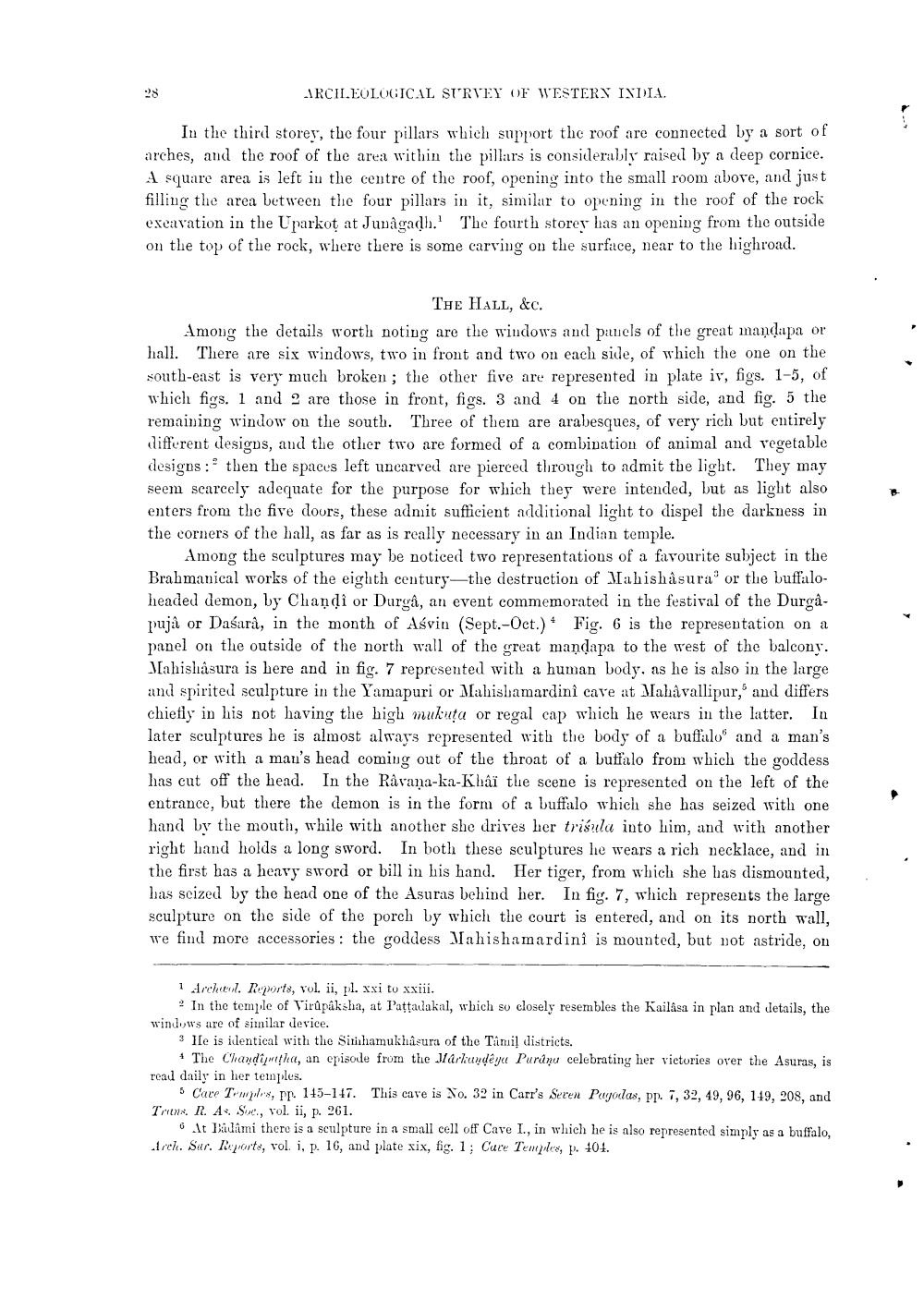________________
IRCILEOLOGICAL SURVEY OF WESTERN INDIA.
In the third storey, the four pillars which support the roof are connected by a sort of arches, and the roof of the area within the pillars is considerably raised by a deep cornice. A square area is left in the centre of the roof, opening into the small room above, and just filling the area between the four pillars in it, similar to opening in the roof of the rock exeavation in the Uparkot at Junagadh. The fourth storey has an opening from the outside on the top of the rock, where there is some carving on the surface, near to the highroad.
THE HALL, &c. Among the details worth noting are the windows and panels of the great mandapa or hall. There are six windows, two in front and two on each side, of which the one on the south-east is very much broken; the other five are represented in plate iv, figs. 1-5, of which figs. 1 and 2 are those in front, figs. 3 and 4 on the north side, and fig. 5 the remaining window on the south. Three of them are arabesques, of very rich but entirely different designs, and the other two are formed of a combination of animal and vegetable desigos: then the spaces left uncarved are pierced through to admit the light. They may seem scarcely adequate for the purpose for which they were intended, but as light also enters from the five doors, these adnit sufficient additional light to dispel the darkness in the corners of the hall, as far as is really necessary in an Indian temple.
Among the sculptures may be noticed two representations of a favourite subject in the Brahmanical works of the eighth century—the destruction of Mahishasura or the buffaloheaded demon, by Chandi or Durga, an event commemorated in the festival of the Durgåpujâ or Daśarà, in the month of Aśvin (Sept.-Oct.)* Fig. 6 is the representation on a panel on the outside of the north wall of the great mandapa to the west of the balcony. Mahishasura is here and in fig. 7 represented with a human body, as he is also in the large and spirited sculpture in the Yamapuri or Mahishiamardinî cave at Mahåvallipur," and differs chiefly in his not having the high mukuta or regal cap which he wears in the latter. In later sculptures he is almost always represented with the body of a buffalo and a man's head, or with a mau's head coming out of the throat of a buffalo from which the goddess has cut off the head. In the Råvana-ka-Khâï the scene is represented on the left of the entrance, but there the demon is in the form of a buffalo which she has seized with one hand by the mouth, while with another she drives her trisula into him, and with another right hand holds a long sword. In both these sculptures he wears a rich necklace, and in the first has a heavy sword or bill in his hand. Her tiger, from which she has dismounted, has scized by the head one of the Asuras behind her. In fig. 7, which represents the large sculpture on the side of the porch by which the court is entered, and on its north wall, we find more accessories: the goddess Mahishamardini is mounted, but not astride, on
1 rcheul. Reports, vol. ii, pl. xxi to xxiii.
. In the temple of Virupaksha, at Pattadakal, which so closely resembles the Kailasa in plan and details, the windows are of similar device.
3 He is identical with the Sitihamukhasura of the Tamil districts.
4 The Chandinha, an episode from the Jlarhundeya Purúnu celebrating her victories over the Asuras, is read daily in her temples.
5 Cave Trwow, pr. 115-117. This cave is No. 32 in Carr's Seren Puyorlas, pp. 7, 32, 49, 96, 119, 208, and Triin R. A St., vol. ii, p. 261.
6.lt Bilimi there is a sculpture in a small cell off Cave I., in which he is also represented simply as a buffalo, trek. Sur. Iports, vol. I, p. 16, and plate xix, fig. 1; Cure Temple, p. 104.




